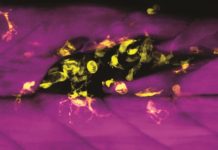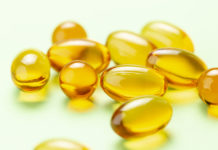Researchers have identified a natural compound found in apple peels, Ursolic acid, as a candidate for preventing the widespread and debilitating muscle wasting condition that affects nearly everyone at one time or another. “Muscle wasting is a frequent companion of illness and aging,” said Christopher Adams of The University of Iowa, Iowa City. “It prolongs hospitalization, delays recoveries and in some cases prevents people from going back home. It isn’t well understood and there is no medicine for it.”

Motivated by the desire to change that, Adams’ team first looked at what happens to gene activity in muscles under conditions that promote weakening. Those studies turned up 63 genes that change in response to fasting in both people and mice and another 29 that shift their expression in the muscles of both people who are fasting and those with spinal cord injury. Comparison of those gene expression signatures to the signatures of cells treated with more than 1300 bioactive small molecules led them to ursolic acid as a compound with effects that might counteract those of atrophy.
“Ursolic acid is an interesting natural compound,” Adams said. “It’s part of a normal diet as a component of apple peels. They always say that an apple a day keeps the doctor away…”
The researchers next gave ursolic acid to fasted mice. Those experiments showed that ursolic acid could protect against muscle weakening as predicted. When ursolic acid was added to the food of normal mice for a period of weeks, their muscles grew. Those effects were traced back to enhanced insulin signaling in muscle and to corrections in the gene signatures linked to atrophy.
Animals given ursolic acid also became leaner and had lower blood levels of glucose, cholesterol and triglycerides. The findings therefore suggest that ursolic acid may be responsible for some of the overall benefits of healthy eating.
“We know if you eat a balanced diet like mom told us to eat you get this material,” Adams said. “People who eat junk food don’t get this.”
It is not yet clear whether the findings in mice will translate to human patients, Adams says, but his goal now is to “figure out if this can help people.” If so, they don’t yet know whether ursolic acid at levels that might be consumed as part of a normal diet might or might not be enough.
Source: Steven D. Kunkel, Manish Suneja, Scott M. Ebert, Kale S. Bongers, Daniel K. Fox, Sharon E. Malmberg, Fariborz Alipour, Richard K. Shields, Christopher M. Adams. mRNA Expression Signatures of Human Skeletal Muscle Atrophy Identify a Natural Compound that Increases Muscle Mass. Cell Metabolism, 2011; 13 (6): 627-638 DOI: 10.1016/j.cmet.2011.03.020















Ursolic acid is a fascinating compound that should be more widely known about. In addition to being able to reduce muscle atrophy and to stimulate muscle growth, an act as a cardio-protective compound, ursolic acid has also been shown to be capable of inhibiting various cancer cell types, one of which includes human fibrosarcoma. It does this by reducing expression of matrix metalloproteinase-9 via glucocorticoid receptors. It may also decrease proliferation of cancer cells and may induce apoptosis under physiological concentrations, (shown to induce eryptosis (the apoptosis-like suicidal cell death in defective red blood cells).
Ursolic acid is present in many plants, such as Mirabilis jalapa. And in other foods too besides apples (which have the highest concentration in its peels): basil, bilberries, cranberries, elder flower, peppermint, rosemary, lavender, oregano, thyme, hawthorn, and prunes.